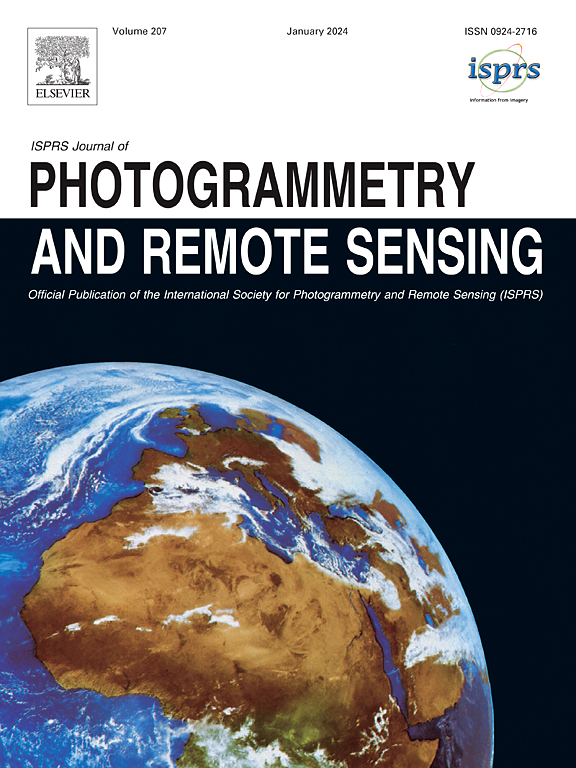克服遥感影像检测建筑物变化的不确定性挑战
IF 10.6
1区 地球科学
Q1 GEOGRAPHY, PHYSICAL
ISPRS Journal of Photogrammetry and Remote Sensing
Pub Date : 2025-02-01
DOI:10.1016/j.isprsjprs.2024.11.017
引用次数: 0
摘要
利用高分辨率的多时相遥感(RS)图像检测建筑变化可以帮助我们了解城市化和人类活动,从而在城市规划、资源分配和基础设施发展方面做出明智的决策。然而,现有的建筑变化检测(BCD)方法通常忽略了RS图像中存在的关键不确定性现象。具体来说,这些不确定性来自两个主要来源:首先,当前的建筑物变化检测数据集主要用于检测建筑物的变化,而其他土地覆盖类别的变化通常被归类为不变背景。由于手工标记过程,类似建筑物的背景元素(如道路和桥梁)有很大的风险被错误地分类为建筑物变化,从而在数据层面上引入任意的不确定性。其次,建筑物部分的变化会影响外观、纹理或风格,但不会改变其语义,这被称为伪变化,以及变化样本和未变化样本之间的不平衡,共同导致模型层面的认知不确定性。为了应对这些挑战,我们提出了一个不确定性感知BCD (UA-BCD)框架。详细地说,我们使用暹罗金字塔视觉转换器从双时相图像中提取多层次特征,然后通过通用解码器对其进行解码,以获得具有固有不确定性的粗糙变化图。随后,引入任意不确定性估计模块,对任意不确定性进行估计并嵌入到特征空间中。然后,开发了知识引导的特征增强模块,利用粗糙图中编码的知识对多层次特征进行增强,生成精细化的变化图。最后,我们提出了一个认知不确定性估计器,它以双时相图像和改进的变化图作为输入和输出对认知不确定性的估计。这种估计由从精化图中计算的熵来监督,确保UA-BCD框架可以产生具有较低认知不确定性的变化图。为了全面验证UA-BCD框架的有效性,我们采用了双视角验证方法。在五个公共建筑变化数据集上进行的大量实验表明,所提出的方法比当前最先进的方法具有显着优势。此外,在中国武汉东西湖区的应用验证了该方法在大规模BCD中的优异性能。该项目的源代码可从https://github.com/Henryjiepanli/UA-BCD获得。本文章由计算机程序翻译,如有差异,请以英文原文为准。
Overcoming the uncertainty challenges in detecting building changes from remote sensing images
Detecting building changes with multi-temporal remote sensing (RS) imagery at a very high resolution can help us understand urbanization and human activities, making informed decisions in urban planning, resource allocation, and infrastructure development. However, existing methods for building change detection (BCD) generally overlook critical uncertainty phenomena presented in RS imagery. Specifically, these uncertainties arise from two main sources: First, current building change detection datasets are designed primarily to detect changes in buildings, while changes in other land-cover classes are often classified as an unchanged background. Because of the manual labeling process, background elements that resemble buildings, such as roads and bridges, are at significant risk of being misclassified as building changes, introducing aleatoric uncertainty at the data level. Second, changes in parts of buildings that affect appearance, texture, or style without altering their semantic meaning, known as pseudo-changes, along with the imbalance between changed and unchanged samples, together lead to epistemic uncertainty at the model level. To address these challenges, we present an Uncertainty-Aware BCD (UA-BCD) framework. In detail, we employ a Siamese pyramid vision transformer to extract multi-level features from bi-temporal images, which are then decoded via a general decoder to obtain a coarse change map with inherent uncertainty. Subsequently, we introduce the aleatoric uncertainty estimation module to estimate the aleatoric uncertainty and embed it into the feature space. Then, a knowledge-guided feature enhancement module is developed to leverage the knowledge encoded in the coarse map to enhance the multi-level features and generate a refined change map. Finally, we propose an epistemic uncertainty estimator that takes the bi-temporal images and the refined change map as input and outputs an estimate of epistemic uncertainty. This estimation is supervised by the entropy calculated from the refined map, ensuring that the UA-BCD framework can produce a change map with lower epistemic uncertainty. To comprehensively validate the efficacy of the UA-BCD framework, we adopt a dual-perspective verification approach. Extensive experiments on five public building change datasets demonstrate the significant advantages of the proposed method over current state-of-the-art methods. Additionally, an application in Dongxihu District, Wuhan, China, confirms the outstanding performance of the proposed method in large-scale BCD. The source code of the project is available at https://github.com/Henryjiepanli/UA-BCD.
求助全文
通过发布文献求助,成功后即可免费获取论文全文。
去求助
来源期刊

ISPRS Journal of Photogrammetry and Remote Sensing
工程技术-成像科学与照相技术
CiteScore
21.00
自引率
6.30%
发文量
273
审稿时长
40 days
期刊介绍:
The ISPRS Journal of Photogrammetry and Remote Sensing (P&RS) serves as the official journal of the International Society for Photogrammetry and Remote Sensing (ISPRS). It acts as a platform for scientists and professionals worldwide who are involved in various disciplines that utilize photogrammetry, remote sensing, spatial information systems, computer vision, and related fields. The journal aims to facilitate communication and dissemination of advancements in these disciplines, while also acting as a comprehensive source of reference and archive.
P&RS endeavors to publish high-quality, peer-reviewed research papers that are preferably original and have not been published before. These papers can cover scientific/research, technological development, or application/practical aspects. Additionally, the journal welcomes papers that are based on presentations from ISPRS meetings, as long as they are considered significant contributions to the aforementioned fields.
In particular, P&RS encourages the submission of papers that are of broad scientific interest, showcase innovative applications (especially in emerging fields), have an interdisciplinary focus, discuss topics that have received limited attention in P&RS or related journals, or explore new directions in scientific or professional realms. It is preferred that theoretical papers include practical applications, while papers focusing on systems and applications should include a theoretical background.
 求助内容:
求助内容: 应助结果提醒方式:
应助结果提醒方式:


